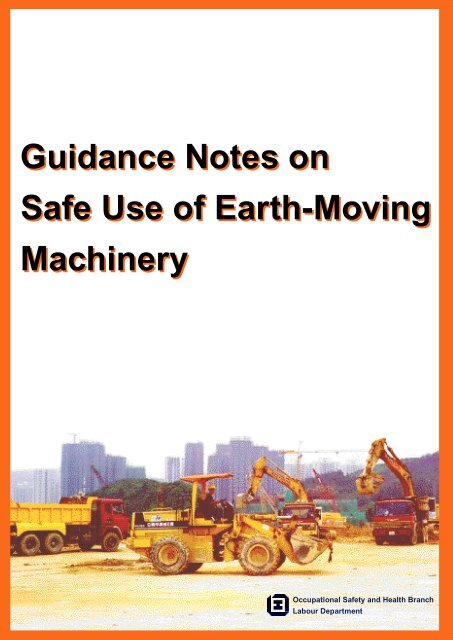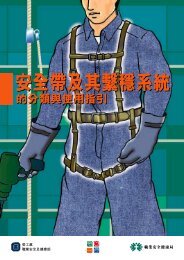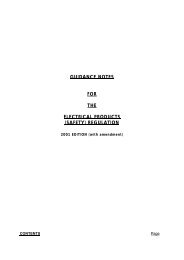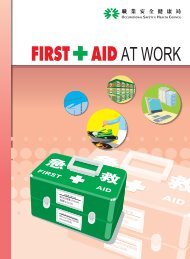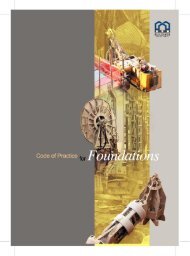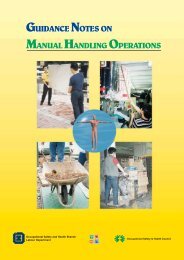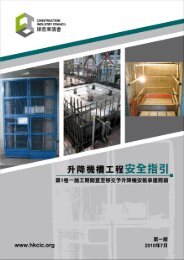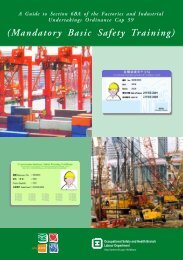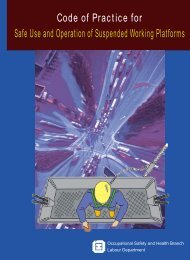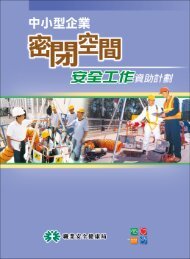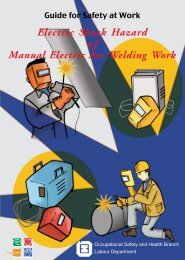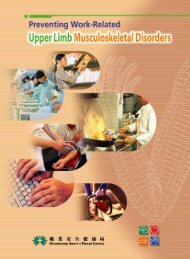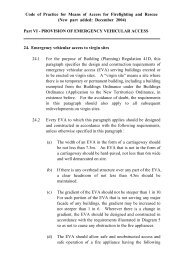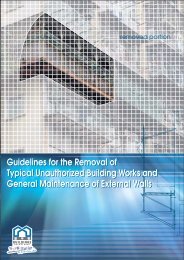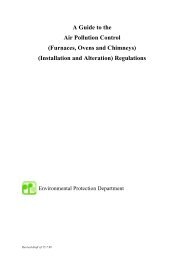Guidance Notes on Safe Use of Earth-Moving Machinery Guidance ...
Guidance Notes on Safe Use of Earth-Moving Machinery Guidance ...
Guidance Notes on Safe Use of Earth-Moving Machinery Guidance ...
You also want an ePaper? Increase the reach of your titles
YUMPU automatically turns print PDFs into web optimized ePapers that Google loves.
<str<strong>on</strong>g>Guidance</str<strong>on</strong>g> <str<strong>on</strong>g>Notes</str<strong>on</strong>g> <strong>on</strong><br />
<strong>Safe</strong> <strong>Use</strong> <strong>of</strong> <strong>Earth</strong>-<strong>Moving</strong><br />
<strong>Machinery</strong><br />
Occupati<strong>on</strong>al <strong>Safe</strong>ty and Health Branch<br />
Labour Department
<str<strong>on</strong>g>Guidance</str<strong>on</strong>g> <str<strong>on</strong>g>Notes</str<strong>on</strong>g> <strong>on</strong><br />
<strong>Safe</strong> <strong>Use</strong> <strong>of</strong> <strong>Earth</strong>-<strong>Moving</strong> <strong>Machinery</strong>
This guidance notes is prepared by the<br />
Occupati<strong>on</strong>al <strong>Safe</strong>ty and Health Branch<br />
Labour Department<br />
First editi<strong>on</strong> September 1998<br />
This guidance notes is issued free <strong>of</strong> charge and can be obtained from<br />
<strong>of</strong>fices <strong>of</strong> the Occupati<strong>on</strong>al <strong>Safe</strong>ty and Health Branch. Addresses and<br />
teleph<strong>on</strong>e numbers <strong>of</strong> the <strong>of</strong>fices can be found in the booklet "The Labour<br />
Department Offers You its Services" or by teleph<strong>on</strong>e 2559 2297.
1. INTRODUCTION<br />
2. SAFE SYSTEM OF WORK<br />
3. SELECTION OF MACHINERY<br />
Table <strong>of</strong> C<strong>on</strong>tents<br />
4. ON SITE INSPECTION AND MAINTENANCE<br />
5. SAFE OPERATION<br />
6. OWNER<br />
7. RESPONSIBILITY OF SITE PERSONNEL<br />
8. COMPETENCE OF MECHANIC<br />
9. COMPETENCE OF OPERATOR<br />
10. SAFETY NOTES<br />
USEFUL INFORMATION<br />
2<br />
6<br />
9<br />
11<br />
14<br />
21<br />
22<br />
24<br />
26<br />
29<br />
31<br />
1
2<br />
1 . INTRODUCTION<br />
1.1 In recent years there has been an increasing spate <strong>of</strong> serious<br />
accidents arising from the use <strong>of</strong> earth-moving machines <strong>on</strong> c<strong>on</strong>structi<strong>on</strong><br />
sites. The comm<strong>on</strong> causes <strong>of</strong> these accidents are <strong>of</strong>ten due to the absence<br />
<strong>of</strong> a safe system <strong>of</strong> work for the operati<strong>on</strong>, inappropriate selecti<strong>on</strong> <strong>on</strong> the<br />
use <strong>of</strong> the equipment, operators being not properly trained and incompetent,<br />
poor maintenance <strong>of</strong> the equipment and failure in observing the necessary<br />
safety precauti<strong>on</strong>s.<br />
1.2 The legal obligati<strong>on</strong>s <strong>on</strong> employers and c<strong>on</strong>tractors in relati<strong>on</strong> to<br />
the safe operati<strong>on</strong> <strong>of</strong> earth-moving machines <strong>on</strong> c<strong>on</strong>structi<strong>on</strong> sites are laid<br />
down under the provisi<strong>on</strong>s <strong>of</strong> the Factories and Industrial Undertakings<br />
Ordinance and its subsidiary regulati<strong>on</strong>.<br />
1.3 Regulati<strong>on</strong> 45 <strong>of</strong> the C<strong>on</strong>structi<strong>on</strong> Sites (<strong>Safe</strong>ty) Regulati<strong>on</strong>s requires<br />
that <strong>on</strong>ly trained and competent workman over 18 years <strong>of</strong> age is allowed<br />
to operate a mechanical equipment inside a c<strong>on</strong>structi<strong>on</strong> site. No pers<strong>on</strong><br />
under 18 years <strong>of</strong> age is allowed to give signals to the operator <strong>of</strong> the<br />
equipment. C<strong>on</strong>traventi<strong>on</strong> <strong>of</strong> the said regulati<strong>on</strong> would be an <strong>of</strong>fence and is<br />
liable to a fine <strong>of</strong> $50,000.<br />
1.4 Mechanical equipment includes any bulldozer, compactor, dumper,<br />
excavator, grader, loader, locomotive, lorry, scraper, truck and any mobile<br />
machine which is used for the handling <strong>of</strong> any material <strong>on</strong> a c<strong>on</strong>structi<strong>on</strong><br />
site. Mechanical equipment includes earth-moving machines. Am<strong>on</strong>gst the<br />
listed mechanical equipment, excavators are lifting appliances in the c<strong>on</strong>text<br />
<strong>of</strong> the Factories and Industrial Undertakings (Lifting Appliances and Lifting<br />
Gear) Regulati<strong>on</strong>s. Excavators should be inspected, thoroughly examined<br />
and tested periodically in accordance with the statutory requirements. Figure<br />
1 illustrates some <strong>of</strong> the earth-moving equipment comm<strong>on</strong>ly used in<br />
c<strong>on</strong>structi<strong>on</strong> sites.
1.5 The Factories and Industrial Undertakings Ordinance (FIUO) also<br />
imposes general duties <strong>on</strong> every proprietor with regard to the health and<br />
safety at work <strong>of</strong> his employees in industrial undertakings which cover<br />
c<strong>on</strong>structi<strong>on</strong> sites. This includes the legal requirements to provide plant and<br />
system <strong>of</strong> work that are, so far as is reas<strong>on</strong>ably practicable, safe and without<br />
risk to health. The general duties extend to include the provisi<strong>on</strong> <strong>of</strong><br />
informati<strong>on</strong>, instructi<strong>on</strong>, training and supervisi<strong>on</strong> for all pers<strong>on</strong>s employed<br />
by him. The proprietor and c<strong>on</strong>tractor must provide all necessary informati<strong>on</strong>,<br />
instructi<strong>on</strong>, training and supervisi<strong>on</strong> for operators <strong>of</strong> earth-moving machines.<br />
A proprietor or a c<strong>on</strong>tractor who fails to observe the above legal provisi<strong>on</strong>s<br />
commits an <strong>of</strong>fence and is liable <strong>on</strong> c<strong>on</strong>victi<strong>on</strong> to a fine <strong>of</strong> $500,000 and to<br />
impris<strong>on</strong>ment for 6 m<strong>on</strong>ths.<br />
1.6 Secti<strong>on</strong> 6B <strong>of</strong> the FIUO also imposes a legal obligati<strong>on</strong> to an<br />
employee, including an operator <strong>of</strong> an earth-moving machine, to take<br />
reas<strong>on</strong>able care for the health and safety <strong>of</strong> himself and <strong>of</strong> other pers<strong>on</strong>s<br />
who may be affected by his act or omissi<strong>on</strong>s at work. Any pers<strong>on</strong> who failed<br />
to observe the requirement commits an <strong>of</strong>fence and is liable <strong>on</strong> c<strong>on</strong>victi<strong>on</strong><br />
to a fine <strong>of</strong> $50,000 and to impris<strong>on</strong>ment for 6 m<strong>on</strong>ths.<br />
1.7 This <str<strong>on</strong>g>Guidance</str<strong>on</strong>g> <str<strong>on</strong>g>Notes</str<strong>on</strong>g>, set out in details from secti<strong>on</strong> 2 <strong>on</strong>wards,<br />
aims to provide the essential safety guidelines to the owners, c<strong>on</strong>tractors,<br />
site management pers<strong>on</strong>nel, mechanics and operators in the c<strong>on</strong>structi<strong>on</strong><br />
industry for improving the safety standard in c<strong>on</strong>necti<strong>on</strong> with the use <strong>of</strong><br />
earth-moving machinery. Reference should always be made to individual<br />
operati<strong>on</strong> and maintenance manual for handling a specific machine to ensure<br />
the safety <strong>of</strong> the operators and the site pers<strong>on</strong>nel working in the vicinity.<br />
1.8 The C<strong>on</strong>structi<strong>on</strong> Industry Training Authority's training centre <strong>of</strong>fers<br />
'<strong>Earth</strong>-<strong>Moving</strong> Machine Operati<strong>on</strong> Course' for workers. Pers<strong>on</strong>s having<br />
successfully completed the course are generally c<strong>on</strong>sidered 'trained and<br />
competent' to operate the relevant machine.<br />
3
4<br />
1.9 Advice and informati<strong>on</strong> regarding the legal aspects and operati<strong>on</strong>al<br />
safety involving the use <strong>of</strong> such type <strong>of</strong> machines can be obtained at the<br />
branch <strong>of</strong>fices <strong>of</strong> the Occupati<strong>on</strong>al <strong>Safe</strong>ty and Health Branch <strong>of</strong> the Labour<br />
Department. The Advisory & Development Divisi<strong>on</strong> under the same branch<br />
<strong>of</strong> this department also <strong>of</strong>fers general advice and assistance <strong>on</strong> the subject.<br />
<strong>Use</strong>ful informati<strong>on</strong> can be found at the back <strong>of</strong> this guidance notes.
SHOVEL LOADER EXCAVATOR<br />
VIBRATING ROLLER BULL DOZER<br />
TRACTOR GRADER<br />
DUMPER SCRAPER<br />
Fig.1 The earth-moving machines<br />
5
6<br />
2 . SAFE SYSTEM OF WORK<br />
2.1 A safe system <strong>of</strong> work should be established prior to any earth<br />
moving operati<strong>on</strong> and this system should be followed by all pers<strong>on</strong>nel<br />
engaged in the earth moving operati<strong>on</strong>. The system should be prepared<br />
and endorsed by the owner / c<strong>on</strong>tractor, under the advice <strong>of</strong> project engineer,<br />
service engineer, mechanic, safety <strong>of</strong>ficer and other relevant pers<strong>on</strong>nel. In<br />
particular,both written and verbal instructi<strong>on</strong>s about the safe system <strong>of</strong> work<br />
should be provided to the machine operator prior to the earth moving<br />
operati<strong>on</strong>.<br />
2.2 The safe system <strong>of</strong> work should include the followings:<br />
(a) risk assessment. Before using a specific type <strong>of</strong> earth-moving<br />
plant <strong>on</strong> a particular site, a risk assessment should be carried<br />
out. Limitati<strong>on</strong>s in using the plant to suit the particular site<br />
c<strong>on</strong>diti<strong>on</strong>s and geotechnical parameters should be specified and<br />
mutually agreed by a pers<strong>on</strong> competent in geotechnics and a<br />
pers<strong>on</strong> competent in mechanical plant. Such limitati<strong>on</strong>s should<br />
be understood and observed by all parties c<strong>on</strong>cerned;<br />
(b) planning the operati<strong>on</strong>. This includes identificati<strong>on</strong> and<br />
descripti<strong>on</strong> <strong>of</strong> earth moving locati<strong>on</strong>s, scale and durati<strong>on</strong> <strong>of</strong> the<br />
operati<strong>on</strong>, use <strong>of</strong> access road and possible route <strong>of</strong> <strong>on</strong> site<br />
travelling. In particular, the width and gradients <strong>of</strong> the slope,<br />
access road or inclined surface should be properly surveyed<br />
before selecting a proper machine to suit the working<br />
envir<strong>on</strong>ment. If the machine has to enter and work in c<strong>on</strong>fined<br />
areas such as the basement <strong>of</strong> a building or other enclosed<br />
areas, a permit-to-work system should be developed to check<br />
and m<strong>on</strong>itor the level <strong>of</strong> oxygen and any other gases from<br />
unknown sources or the engine exhaust. Moreover, the weather<br />
c<strong>on</strong>diti<strong>on</strong> should be taken into c<strong>on</strong>siderati<strong>on</strong> to ensure that the<br />
operati<strong>on</strong> is not affected by rain, storm or sudden change <strong>of</strong><br />
weather;
(c) selecti<strong>on</strong>, provisi<strong>on</strong> and use <strong>of</strong> a suitable machine for a particular<br />
type <strong>of</strong> operati<strong>on</strong>. C<strong>on</strong>siderati<strong>on</strong> should be given to the following<br />
limitati<strong>on</strong>s: the maximum allowable gradient <strong>of</strong> earth slope to<br />
climb; the minimum distance from crawler tracks/wheels to edges<br />
<strong>of</strong> slopes; rolling resistance <strong>of</strong> rubber-tired plant; tracti<strong>on</strong>; and<br />
ground c<strong>on</strong>diti<strong>on</strong>s at different moisture c<strong>on</strong>tents;<br />
(d) maintenance, inspecti<strong>on</strong>, examinati<strong>on</strong> and testing <strong>of</strong> the<br />
equipment periodically by a mechanic and service engineer and/<br />
or Pr<strong>of</strong>essi<strong>on</strong>al Engineer;<br />
(e) provisi<strong>on</strong> <strong>of</strong> operati<strong>on</strong> and maintenance manual, manufacturer's<br />
specificati<strong>on</strong>, and inspecti<strong>on</strong> and maintenance log book for the<br />
use <strong>of</strong> mechanic, service engineer or other safety pers<strong>on</strong>nel<br />
during the periodic maintenance, inspecti<strong>on</strong>, examinati<strong>on</strong> and<br />
test;<br />
(f) provisi<strong>on</strong> and selecti<strong>on</strong> <strong>of</strong> properly trained and competent<br />
pers<strong>on</strong>nel to operate the machine. The operator should at a<br />
minimum possess a certificate <strong>of</strong> training in operating earth-<br />
moving achinery issued either by the C<strong>on</strong>structi<strong>on</strong> Industry<br />
Training Authority (CITA) or by a local agent <strong>of</strong> a particular type<br />
<strong>of</strong> machine;<br />
(g) adequate supervisi<strong>on</strong> by properly trained and competent<br />
pers<strong>on</strong>nel to execute the rules and precauti<strong>on</strong>s stated in the<br />
safe system <strong>of</strong> work. Such pers<strong>on</strong>nel should have the knowledge<br />
<strong>of</strong> the machine and necessary authority to suspend the earth<br />
moving operati<strong>on</strong> if a dangerous circumstance arises;<br />
(h) preventing unauthorized movement or use <strong>of</strong> machines at all<br />
times;<br />
7
8<br />
(i) observing all potential unsafe c<strong>on</strong>diti<strong>on</strong>s that may arise during<br />
the earth moving operati<strong>on</strong> and introducing preventive measures<br />
to ensure the safe operati<strong>on</strong> <strong>of</strong> the machines at all times. In the<br />
case where the machine is operated in special circumstances<br />
such as in c<strong>on</strong>gested work envir<strong>on</strong>ment, close to nearby fixture,<br />
at dusk or at night, banksman should be assigned to give signal<br />
to the operator <strong>of</strong> the machine;<br />
(j) identificati<strong>on</strong> <strong>of</strong> site pers<strong>on</strong>nel to execute the rules and safety<br />
precauti<strong>on</strong>s, supervise the operati<strong>on</strong> and impose stop work<br />
order for a hazardous working c<strong>on</strong>diti<strong>on</strong>;<br />
(k) procedures and safety precauti<strong>on</strong>s for loading and unloading<br />
the machine <strong>on</strong> site;<br />
(l) emergency preparedness, including the arrangement and<br />
provisi<strong>on</strong> rescue appliances to recover and restore the<br />
equipment; and<br />
(m) checklists for certain 'dos' and 'd<strong>on</strong>'ts' to be observed for safe<br />
operati<strong>on</strong>, maintenance, inspecti<strong>on</strong>,testing and examinati<strong>on</strong> <strong>of</strong><br />
the machine.<br />
2.3 The safe system <strong>of</strong> work should be published in simple language<br />
so that every <strong>on</strong>e can read and understand it. It should be distributed to site<br />
pers<strong>on</strong>nel resp<strong>on</strong>sible for the earth moving operati<strong>on</strong>, including the operator.
3 . SELECTION OF MACHINERY<br />
3.1 It is important to choose a proper machine for a certain type <strong>of</strong><br />
earth moving work. Factors such as whether a new or used machine, its<br />
size and model, whether rubber or track mounting, country <strong>of</strong> original,<br />
availability <strong>of</strong> local agent, maintenance support to meet the working c<strong>on</strong>diti<strong>on</strong><br />
and envir<strong>on</strong>ment etc. should be taken into c<strong>on</strong>siderati<strong>on</strong> in the selecting<br />
process.<br />
3.2 The machine so selected should be:<br />
(a) <strong>of</strong> suitable capacity and power for the nature, quantities and<br />
scale <strong>of</strong> the earth moving work;<br />
(b) <strong>of</strong> good mechanical c<strong>on</strong>diti<strong>on</strong> and properly fitted with all<br />
necessary safety devices, protecti<strong>on</strong> system and correct tread<br />
fittings. The safety and protecti<strong>on</strong> system should include roll over<br />
protecti<strong>on</strong> structure, dead-man c<strong>on</strong>trol, reverse warning device<br />
and amber flashing lights;<br />
(c) thoroughly inspected and maintained by a mechanic in<br />
accordance with the manufacturer's operati<strong>on</strong> and maintenance<br />
manual;<br />
(d) tested and examined periodically by service engineers in<br />
accordance with the requirements set in manufacturer's<br />
specificati<strong>on</strong>; and<br />
(e) accompanied with an inspecti<strong>on</strong> or maintenance log book as<br />
well as test record irrespective <strong>of</strong> whether the machine is a new<br />
<strong>on</strong>e or a used equipment.<br />
9
10<br />
3.3 It is important that whenever a machine is required to work <strong>on</strong> slope<br />
or travel <strong>on</strong> inclined road, the slope limit <strong>of</strong> the machine should be checked.<br />
The machine should be equipped with a roll over protecti<strong>on</strong> structure and a<br />
seat belt as shown in Figure 2 for the safety <strong>of</strong> the operator.<br />
Fig.2 A machine with roll over protecti<strong>on</strong> structure and a seat belt
4 . ON SITE INSPECTION AND MAINTENANCE<br />
MAINTENANCE<br />
4.1 On arrival <strong>of</strong> the machine to site, the operator and mechanic should<br />
walk around the machine, check it carefully according to the check list <strong>of</strong><br />
the machine after it was unloaded. The parts serving particular attenti<strong>on</strong><br />
vary with the type <strong>of</strong> machine, the work it is doing, and <strong>of</strong>ten with the service<br />
history <strong>of</strong> this particular unit. The following parts <strong>of</strong> the machine are <strong>of</strong>ten<br />
required particular attenti<strong>on</strong> and frequent inspecti<strong>on</strong>s:<br />
Tyres<br />
If it has tyres, the correct pattern and directi<strong>on</strong> <strong>of</strong> the tread and proper<br />
pressure are <strong>of</strong> the first importance. They should be checked to see if they<br />
are suitable for the ground c<strong>on</strong>diti<strong>on</strong>s in accordance with the manufacturer's<br />
recommendati<strong>on</strong>. Tyres should be inspected for cuts, tears, and worn tread.<br />
Tracks<br />
Track tensi<strong>on</strong> can be checked <strong>on</strong>ly if the machine is reas<strong>on</strong>ably clean, and<br />
was moving forward when stopped for parking. There should be a slight<br />
sag <strong>on</strong> each side <strong>of</strong> the carrier roller. Too tight a track will wear rapidly, while<br />
if too loose it will also wear rapidly and may come <strong>of</strong>f.<br />
Working Tool<br />
The bucket, blade, edge, tooth or other part that is forced through soil or<br />
rock during earth moving is subject to wear and tear due to abrasi<strong>on</strong> and<br />
impact acti<strong>on</strong>. The operator should be alert to report excessive wear and<br />
any breakage <strong>of</strong> these cutting parts. Excessive wear and a break in the<br />
working tool usually cause the metal part or structure behind them some<br />
tears and bends which make rebuilding difficult.<br />
Linkage<br />
Each hinge is a point where lubricati<strong>on</strong> is probably required, and where a<br />
pin might loosen and come out. Steering linkage acting <strong>on</strong> the wheels is<br />
subject to damage from collisi<strong>on</strong> with rocks or other object. Check for<br />
slackness in the steering and lever c<strong>on</strong>trols and worn brake pedals and<br />
rectify and replace as necessary.<br />
11
12<br />
Leaks<br />
Surfaces <strong>of</strong> the machine, and the ground under it, should be inspected for<br />
evidence <strong>of</strong> leakage <strong>of</strong> lubricating or hydraulic oil, or coolant (see figure 3).<br />
In the hydraulic system, leaks are usually at joints. If the hose itself starts to<br />
exude oil, it should be replaced immediately. Leakage for fuel oil and air-<br />
system should also be inspected. Any evidence <strong>of</strong> leak should be<br />
investigated and rectified with defective parts replaced immediately.<br />
Radiator<br />
The fluid levels should be checked at the beginning <strong>of</strong> each shift. The radiator<br />
should be filled to within a few inches <strong>of</strong> the filler cap. For engine with auxiliary<br />
c<strong>on</strong>tainer for coolant, the level <strong>of</strong> the coolant should be maintained within<br />
the upper and lower levels as indicated or in accordance with the<br />
manufacturer's instructi<strong>on</strong> manual. Never loosen the filler cap <strong>of</strong> the radiator<br />
until the engine is cooled down.<br />
Reservoirs<br />
Almost any piece <strong>of</strong> equipment has <strong>on</strong>e or more fluid reservoirs whose level<br />
is checked by a dip stick, usually while the engine is shut <strong>of</strong>f (see Figure 4).<br />
There is always a dip stick for the engine. The operator must be sure to use<br />
it, and to add oil if necessary, before starting. The tank for hydraulic system<br />
should be checked either by a sight gauge, a dip stick or a look through the<br />
filler cap opening. Air reservoirs (or air-vessels) should be regularly drained<br />
to remove the c<strong>on</strong>densati<strong>on</strong> water to maintain their efficiency.<br />
Air Cleaner<br />
Open and check the presence <strong>of</strong> trash in the air cleaner. Remove any trash<br />
and replace worn out parts. Keep the air cleaner in a serviceable c<strong>on</strong>diti<strong>on</strong><br />
all times.<br />
Roll Over Protecti<strong>on</strong> Structure<br />
Look for any loose or damaged bolts. Replace damaged bolts or missing<br />
bolts with original equipment parts <strong>on</strong>ly. Replace the structure mounting<br />
supports if the structure rattles or makes a noise when the machine is<br />
operated <strong>on</strong> a rough surface.
Seat and Seat Belt<br />
Inspect the c<strong>on</strong>diti<strong>on</strong> <strong>of</strong> the seat, seat belt and the associated mounting<br />
hardware. Replace any damaged or worn parts.<br />
Other safety features<br />
Check c<strong>on</strong>trol butt<strong>on</strong>s, lights and minors.<br />
Battery<br />
Check the c<strong>on</strong>diti<strong>on</strong> <strong>of</strong> the battery, including the c<strong>on</strong>necti<strong>on</strong>s, level <strong>of</strong><br />
electrolyte, and leakage.<br />
4.2 It is important to note that all routine inspecti<strong>on</strong>s and maintenance<br />
work should be d<strong>on</strong>e with all attachments and working tools being completely<br />
lowered <strong>on</strong> ground surface or otherwise firmly supported by safety bars.<br />
5 . SAFE OPERATION<br />
Fig.3 Check for leakage <strong>of</strong> lubricating or hydraulic<br />
oil, or coolant<br />
13
14<br />
5 . SAFE OPERATION<br />
5.1 The following safe precauti<strong>on</strong>s summarize essential requirements<br />
to use and operate an earth-moving plant. In any case, site safety pers<strong>on</strong>nel<br />
should make reference to the safety notes in the operati<strong>on</strong> and maintenance<br />
manual to get a complete picture <strong>of</strong> the machine before it is put into service.<br />
Site preparati<strong>on</strong>s<br />
5.2 Before any earth moving operati<strong>on</strong> is commenced, site pers<strong>on</strong>nel<br />
should carry out site preparati<strong>on</strong>s for safe operati<strong>on</strong> <strong>of</strong> the earth-moving<br />
machinery. The following safety measures should be observed:<br />
(a) provisi<strong>on</strong> <strong>of</strong> temporary fencings and warnings at edges <strong>of</strong><br />
embankments, excavati<strong>on</strong>s and pits against risks <strong>of</strong> roll over;<br />
(b) provisi<strong>on</strong> <strong>of</strong> goal posts and warning signs in the vicinity <strong>of</strong><br />
overhead power lines;<br />
(c) arrangement <strong>of</strong> site traffic c<strong>on</strong>trols;<br />
(d) provisi<strong>on</strong> <strong>of</strong> adequate site access roads;<br />
(e) provisi<strong>on</strong> <strong>of</strong> safety system for other site vehicles such as provisi<strong>on</strong><br />
<strong>of</strong> flashing lights or flags for smaller vehicles in large earth moving<br />
site;<br />
(f) provisi<strong>on</strong> <strong>of</strong> safety measures for dumping pits such as the<br />
installati<strong>on</strong> <strong>of</strong> stop logs to rear wheels <strong>of</strong> dumpers; and<br />
(g) provisi<strong>on</strong> <strong>of</strong> protective equipment for banksmen and any ground<br />
pers<strong>on</strong> assisting in the dumping operati<strong>on</strong>s such as reflective<br />
vests and communicati<strong>on</strong> means.
Prepare for safe operati<strong>on</strong><br />
5.3 Before starting the engine <strong>of</strong> the machine, the operator or mechanic<br />
should pay attenti<strong>on</strong> to the following:<br />
(a) Inspect for any evidence <strong>of</strong> physical damage such as cracking,<br />
bending or deformati<strong>on</strong> <strong>of</strong> plates or welds.<br />
(b) Check the level <strong>of</strong> all fluids in the brake, transmissi<strong>on</strong>, power<br />
steering, engine coolant, hydraulic system. Fill low reservoirs<br />
<strong>on</strong>ly to proper level.<br />
(c) Check various system for leaks. Inspect all plugs, filler caps<br />
and fittings for tell-tale signs <strong>of</strong> leaks.<br />
(d) Before starting the machine, check all c<strong>on</strong>trols such as forward<br />
and reverse, steering, transmissi<strong>on</strong>, and all operating and shut-<br />
down c<strong>on</strong>trols.<br />
(e) Before beginning operati<strong>on</strong>, thoroughly check the area <strong>of</strong> earth<br />
moving operati<strong>on</strong>, its gradients, the c<strong>on</strong>diti<strong>on</strong> <strong>of</strong> access road,<br />
nearby trenches, lightpoles, tiles, overhead or underground<br />
cables, drop-<strong>of</strong>f or overhead obstacles. Other site activities in<br />
the vicinity should be checked as well.<br />
(f) When the machine is intended to operate <strong>on</strong> steep slopes or<br />
move <strong>on</strong> inclined road, the machine must be installed with roll<br />
over protecti<strong>on</strong> structure and seat belt to reduce the hazard to<br />
the operating pers<strong>on</strong>nel.<br />
(g) If an unsafe c<strong>on</strong>diti<strong>on</strong> cannot be remedied immediately, notify<br />
the supervisor and tag the machine <strong>on</strong> the start switch and/or<br />
other appropriate and prominent positi<strong>on</strong>.<br />
15
16<br />
Fig.4 Check the level <strong>of</strong> all fluids in the brake,<br />
Operati<strong>on</strong><br />
5.4 During the operati<strong>on</strong> <strong>of</strong> the machine, the following precauti<strong>on</strong>s should<br />
be adopted by the operator:<br />
(a) Walk around the machine <strong>on</strong>ce more just prior to mounting it .<br />
Check for people and objects that might be in the way.<br />
(b) Just before starting, check all c<strong>on</strong>trols such as forward and<br />
reverse, steering and transmissi<strong>on</strong> to ensure they are in the correct<br />
start-up positi<strong>on</strong>.The parking brake should be applied during the<br />
start-up operati<strong>on</strong>.<br />
(c) Check for proper functi<strong>on</strong>ing <strong>of</strong> all operating and shut-down<br />
c<strong>on</strong>trols.<br />
transmissi<strong>on</strong>, power steering, engine coolant<br />
and hydraulic system
(d) After starting the engine, check gauges, instruments and warning<br />
lights,all c<strong>on</strong>trols and all warning and safety devices and<br />
indicators. Check operati<strong>on</strong> <strong>of</strong> service and parking services <strong>on</strong><br />
level ground if possible according to the manufacturer's<br />
instructi<strong>on</strong>s. Particular attenti<strong>on</strong> should be focused <strong>on</strong> abnormal<br />
noise, undue vibrati<strong>on</strong> and smell.<br />
(e) Check service brakes in both forward and reverse operati<strong>on</strong> in<br />
level ground according to the manufacturer's instructi<strong>on</strong>s.<br />
(f) When operating a machine, always stay in the operator's stati<strong>on</strong><br />
and fasten the seat belt if so provided. Never mount or dismount<br />
a machine unless it is stati<strong>on</strong>ary. If the machine is equipped<br />
with a cabin, ensure that the cabin door is securely closed.<br />
(g) Always operate the machine slowly until fully familiarized with<br />
its c<strong>on</strong>trol.<br />
(h) Prevent asphyxiati<strong>on</strong>. If you must operate in a building or other<br />
enclosed area, be sure that there is sufficient ventilati<strong>on</strong> at that<br />
area for effective dispersi<strong>on</strong> <strong>of</strong> the engine exhaust. If your<br />
machine is equipped with an enclosed cabin, be certain there<br />
is adequate ventilati<strong>on</strong>.<br />
(i) When working <strong>on</strong> slopes, avoid sidehill travel whenever possible.<br />
The danger <strong>of</strong> sliding and tipping during sidehill is always present<br />
regardless <strong>of</strong> how heavy or stable your machine may appear to<br />
be. Figure 5 illustrated the sidehill travel <strong>of</strong> a loader.<br />
17
18<br />
Fig . 5 When working <strong>on</strong> slope, avoid sidehill travel<br />
(j) Always fasten the seat belt if your machine is equipped with a<br />
roll over protecti<strong>on</strong> structure.<br />
(k) When climbing or descending steep slopes, always select the<br />
proper gear before proceeding to the slope to assure adequate<br />
power or engine braking. If your machine has a gear shift, select<br />
a low gear. If your machine has a hydrostatic drive, the speed<br />
c<strong>on</strong>trol should be in the slow travel positi<strong>on</strong>, close to neutral.<br />
Never engage in the fully displace positi<strong>on</strong>.<br />
(l) When climbing or descending slopes, <strong>on</strong> machines that have a<br />
gear shift and a hydrostatic c<strong>on</strong>trol, both c<strong>on</strong>trols must be in<br />
their slow travel positi<strong>on</strong>. Always be sure that manually operated<br />
gear type transmissi<strong>on</strong>s are fully engaged before proceeding<br />
to the slope.
(m) Avoid operating the machine too close to an overhang, deep<br />
ditch or hole and be alert to potential caving edges, falling rocks<br />
and slides, rough terrain, obstacles and overhead lines.<br />
(n) In case <strong>of</strong> restricti<strong>on</strong> <strong>of</strong> the view <strong>of</strong> the operator, do not operate<br />
the machine unless a banksman is available for giving signal for<br />
safe operati<strong>on</strong>.<br />
(o) Under wet or rainy c<strong>on</strong>diti<strong>on</strong>s when the ground became too<br />
slippery for the machine, stop the earth moving operati<strong>on</strong>.<br />
(p) Never operate the machine in any place <strong>of</strong> inadequate lighting.<br />
Adequate lighting should be arranged in c<strong>on</strong>fined areas and<br />
during operati<strong>on</strong> at night time.<br />
(q) Never leave the machine while the engine is running and igniti<strong>on</strong><br />
key is <strong>on</strong> the machine.<br />
(r) Never use the machine for any purposes other than it is designed<br />
for.<br />
Parking<br />
5.5 Having finished the earth moving operati<strong>on</strong>, the machine should be<br />
stati<strong>on</strong>ed in a place <strong>of</strong>f the work area or access road. The following points<br />
should be noted:<br />
(a) Park <strong>on</strong> level ground, with the parking brake firmly applied and<br />
blocked by suitable wedges, where appropriate. For wheeled<br />
machine, the wheels should be chocked by suitable wedges<br />
and never chock the wheels with rocks. Avoid parking near<br />
edges <strong>of</strong> slopes and excavati<strong>on</strong>s.<br />
19
20<br />
(b) Lower the attachments or working tools to the ground.<br />
(c) Remove the igniti<strong>on</strong> key and hand it back to the site pers<strong>on</strong>nel<br />
for safe custody.<br />
Fig.6 Park <strong>on</strong> level ground and with attachment <strong>on</strong> ground
J<br />
6 . OWNER<br />
6.1 The owner <strong>of</strong> the machine should ensure that the machine is <strong>of</strong> good<br />
mechanical c<strong>on</strong>structi<strong>on</strong> and free from patent defects before the machine<br />
is used for earth moving operati<strong>on</strong>. He should ensure that the machine is<br />
maintained to its efficient state by his service engineer and mechanic in<br />
accordance with the manufacturer's specificati<strong>on</strong>. In the case where<br />
excavators are used, he should also ensure that the machines are inspected,<br />
thoroughly examined and tested periodically in accordance with the Factories<br />
and Industrial Undertakings (Lifting Appliances and Lifting Gear)<br />
Regulati<strong>on</strong>s.<br />
6.2 Tests for service and parking brakes, steering alignment, check for<br />
pump efficiency, travel speed test, test for hydraulic pressure <strong>of</strong> the power<br />
system, should be c<strong>on</strong>ducted in the workshop within the maintenance<br />
intervals and also after repair in accordance with the manufacturer's<br />
instructi<strong>on</strong>s. A systematic recording <strong>of</strong> all tests and servicing data and<br />
periods should be kept and available for reference.<br />
6.3 The service and maintenance records and essential safety<br />
precauti<strong>on</strong> notes should be provided and accompany the machine for the<br />
reference <strong>of</strong> the hirer and operator.<br />
6.4 The owner should provide informati<strong>on</strong> c<strong>on</strong>cerning the dimensi<strong>on</strong>s,<br />
weight, and c<strong>on</strong>figurati<strong>on</strong> <strong>of</strong> the machine for loading and unloading, and in<br />
case <strong>of</strong> mishap, the recovery procedure.<br />
6.5 The owner should provide basic, <strong>on</strong>-the-job, and where appropriate<br />
advanced training to machine operator.<br />
21
22<br />
7 . RESPONSIBILITY OF SITE PERSONNEL<br />
7.1 A safe system <strong>of</strong> work should be drawn up by the c<strong>on</strong>tractor<br />
management and site pers<strong>on</strong>nel to ensure the safety <strong>of</strong> the earth moving<br />
operati<strong>on</strong>. It should be distributed to all relevant pers<strong>on</strong>nel within the site.<br />
The steps, such as briefing, tool box talks and coaching, should be taken to<br />
ensure that the safe system <strong>of</strong> work is fully understood by all relevant<br />
pers<strong>on</strong>nel.<br />
7.2 The site pers<strong>on</strong>nel should exercise c<strong>on</strong>trol over the following areas:<br />
(a) never allow unqualified or unauthorized pers<strong>on</strong>nel to operate<br />
the machine. Preferably, the authorizati<strong>on</strong> should be in written<br />
documentati<strong>on</strong>;<br />
(b) never allow other pers<strong>on</strong>nel to ride <strong>on</strong> the machine unless<br />
appropriate seating is provided and <strong>on</strong>ly if authorized to do so;<br />
(c) never allow the machine to perform operati<strong>on</strong> which is not<br />
specified by the manufacturer;<br />
(d) circle <strong>of</strong>f a parking area for the machine when it is not in use.<br />
Park in an <strong>of</strong>f the road area, out <strong>of</strong> traffic. If the machine has to<br />
be parked in a traffic lane, use the appropriate barriers, lights<br />
and warning signal to warn the approaching traffic; and<br />
(e) the parking area should be <strong>of</strong> level ground whenever possible.<br />
Ensure that the machine is safely blocked and the parking brake<br />
is firmly applied.<br />
7.3 Loading and unloading machines always involves potential hazards.<br />
The site pers<strong>on</strong>nel should develop a method statement for the correct loading<br />
and unloading for the machine in the site.The procedure recommended by<br />
the manufacturer should always be followed.
7.4 Reas<strong>on</strong>able steps should be taken to ensure that the operator is<br />
trained and competent to operate the machine. A simple test c<strong>on</strong>ducted by<br />
the mechanic <strong>of</strong> the equipment such as the knowledge <strong>on</strong> safety precauti<strong>on</strong>s<br />
<strong>of</strong> the machine is <strong>of</strong> <strong>of</strong>ten helpful to reveal the competence <strong>of</strong> the operator.<br />
7.5 Maintenance and test record <strong>of</strong> the machine should be kept in the<br />
site for reference.<br />
8 . COMPETENCE OF MECHANIC<br />
23
24<br />
7<br />
8 . COMPETENCE OF MECHANIC<br />
8.1 The mechanic for inspecti<strong>on</strong> and maintenance <strong>of</strong> earth-moving<br />
machinery should receive the necessary training both in safety knowledge<br />
and precauti<strong>on</strong>s. He should be fully familiar with the following aspects <strong>of</strong><br />
knowledge and skill:<br />
(a) the understanding and applicati<strong>on</strong> <strong>of</strong> the local safety regulati<strong>on</strong>s<br />
such as the C<strong>on</strong>structi<strong>on</strong> Sites (<strong>Safe</strong>ty) Regulati<strong>on</strong>s, the Factories<br />
and Industrial Undertakings (Lifting Appliances and Lifting Gear)<br />
Regulati<strong>on</strong>s, and the general duties provisi<strong>on</strong>s <strong>of</strong> the Factories<br />
and Industrial Undertakings Ordinance, Cap 59;<br />
(b) precauti<strong>on</strong>s to be observed when operating earth-moving<br />
equipment and attachments, and the safe and proper handling<br />
<strong>of</strong> all hydraulic tools, air tools, special tools and equipment;<br />
(c) locati<strong>on</strong> <strong>of</strong> master switches and methods <strong>of</strong> immobilizing<br />
machinery, including the type <strong>of</strong> earth-moving base and<br />
equipment;<br />
(d) dangers associated with high pressure systems;<br />
(e) safe method <strong>of</strong> dismantling wheels and the use <strong>of</strong> a protective<br />
cage during inflati<strong>on</strong> <strong>of</strong> tyres and hydro-inflati<strong>on</strong>, etc.;<br />
(f) the skill <strong>of</strong> using hand tools and power tool as applied to<br />
maintenance and servicing requirements;<br />
(g) the requirements and technicalities <strong>of</strong> scheduled servicing,<br />
routine repairs and maintenance <strong>on</strong> sites, and major workshop<br />
repairs and overhauls. This includes the checking <strong>of</strong> the correct<br />
functi<strong>on</strong>ing <strong>of</strong> ancillary systems, the steering wheel alignment,<br />
the experience <strong>of</strong> assisting in the recovery <strong>of</strong> damaged machines
and use <strong>of</strong> instrument for fault diagnosis, and the applicati<strong>on</strong> <strong>of</strong><br />
the lubricati<strong>on</strong> charts and use <strong>of</strong> maintenance and lubricati<strong>on</strong><br />
manuals; and<br />
(h) all safety rules and precauti<strong>on</strong>s as defined in the operati<strong>on</strong> and<br />
maintenance manual and, in particular, the maintenance intervals<br />
<strong>of</strong> the machine he is resp<strong>on</strong>sible for <strong>on</strong>-site maintenance.<br />
8.2 The mechanic should be able to c<strong>on</strong>duct simple tests <strong>on</strong> site<br />
according to the manufacturer's specificati<strong>on</strong>, including service and parking<br />
brakes, steering mechanism, and safety switches and interlocks. He should<br />
keep a record <strong>of</strong> service <strong>of</strong> the machine and make available for inspecti<strong>on</strong><br />
by site pers<strong>on</strong>nel. He should be capable <strong>of</strong> preparing simple technical<br />
reports outlining the main findings and the cause <strong>of</strong> the accident.<br />
25
26<br />
j<br />
9 . COMPETENCE OF OPERATOR<br />
9.1 The operator should be at least 18 years old and have reas<strong>on</strong>able<br />
degree <strong>of</strong> both physical and mental fitness.<br />
9.2 The operator should be able to understand what is involved in safe<br />
operati<strong>on</strong>. He should be able to understand and read instructi<strong>on</strong>s, signs,<br />
charts and manuals.<br />
9.3 The operator should receive both basic training and advanced<br />
training for specialized groups <strong>of</strong> machines. Throughout the training it must<br />
c<strong>on</strong>tinually be emphasized that <strong>on</strong>e <strong>of</strong> the most important aspects <strong>of</strong><br />
machine operati<strong>on</strong> and servicing is safety.<br />
9.4 After the completi<strong>on</strong> <strong>of</strong> the basic training, the operator should be<br />
able to understand and appreciate the following:<br />
(a) the designed purpose, capabilities, capacities and limitati<strong>on</strong>s<br />
<strong>of</strong> the machine;<br />
(b) the procedures for the preparati<strong>on</strong> for operati<strong>on</strong>, operati<strong>on</strong>,<br />
parking, loading and unloading ;<br />
(c) basic dimensi<strong>on</strong>al data such as length, width, mass, ground<br />
bearing pressure, speed ,etc.;<br />
(d) appreciati<strong>on</strong> <strong>of</strong> the factors affecting machine productivity;<br />
(e) routine inspecti<strong>on</strong> and servicing tasks appropriate to him;<br />
(f) the use <strong>of</strong> machine to meet the work c<strong>on</strong>diti<strong>on</strong>, such as c<strong>on</strong>fined<br />
areas, cold stores, slopes, rough terrain, and bad weather<br />
c<strong>on</strong>diti<strong>on</strong>;
(g) the use <strong>of</strong> pers<strong>on</strong>al protective equipment, including the functi<strong>on</strong><br />
and use <strong>of</strong> seat belt;<br />
(h) the acti<strong>on</strong> to be taken in emergency and rescue procedures;<br />
and<br />
(i) machinery defect reporting procedure.<br />
9.5 After the basic training, the operator should be arranged for advance<br />
training for a machine group. The operator should be able to understand<br />
and appreciate the following up<strong>on</strong> completi<strong>on</strong> <strong>of</strong> the advance training for<br />
the specific group <strong>of</strong> machine:<br />
(a) operator's c<strong>on</strong>trols;<br />
(b) commissi<strong>on</strong>ing, starting and stopping;<br />
(c) daily operati<strong>on</strong>, including checks prior to operating the machine,<br />
during the operati<strong>on</strong>, and advice <strong>on</strong> efficient and safe operati<strong>on</strong>;<br />
(d) movement <strong>of</strong> machine between work sites;<br />
(e) special c<strong>on</strong>diti<strong>on</strong>s <strong>of</strong> use,<br />
(f) correct use and disposal <strong>of</strong> fuels, lubricants, grease, hydraulic<br />
fluids and coolants;<br />
(g) correct methods for refuelling and applying lubricati<strong>on</strong>s and the<br />
required safety precauti<strong>on</strong>s;<br />
(h) routine servicing <strong>of</strong> hydraulic and air system;<br />
(i) routine repairs and malfuncti<strong>on</strong> problems; and<br />
(j) reacti<strong>on</strong> in case <strong>of</strong> particular situati<strong>on</strong>, e.g. wheel stuck or slid.<br />
27
28<br />
9.6 An operator who possesses a certificate <strong>of</strong> training in earth moving<br />
operati<strong>on</strong> issued by CITA is regarded as 'trained and competent' to operate<br />
the machine (see secti<strong>on</strong>s 1.7 and 2.2f).
10 . SAFETY NOTES<br />
10.1 It is important to ensure that the machine is operated safely. Re-<br />
emphasis <strong>on</strong> SAFETY is the most important aspects <strong>of</strong> training and machine<br />
operati<strong>on</strong>. Some typical subjects are:<br />
(a) regarding the machine, including chocking the wheels, parking<br />
etc.;<br />
(b) regarding the site, including do not work <strong>on</strong> a machine <strong>on</strong> a<br />
slope which is liable to collapse and slid;<br />
(c) do not work above or under overhanging embankments or<br />
undercut with potential hazard <strong>of</strong> collapse;<br />
(d) ensure buckets, blades and any sharp attachment to be lowered<br />
to ground after completing the work;<br />
(e) watch for trees and branches and overhead lines;<br />
(f) ensure all safety devices are always intact and fully operati<strong>on</strong>al,<br />
including, for example, emergency brakes and steering, reverse<br />
alarms, headlights, and roll over protecti<strong>on</strong> structure and seat<br />
belt;<br />
(g) greasing and other servicing or repair work should not be carried<br />
out when the engine is running;<br />
(h) identificati<strong>on</strong> and observati<strong>on</strong> <strong>of</strong> safety signs, notices and<br />
symbols; and<br />
(i) the machine should be repaired by competent mechanic and<br />
service engineer and <strong>on</strong>ly genuine spare parts should be used.<br />
29
30<br />
10.2 Operator, mechanic and site pers<strong>on</strong>nel working in c<strong>on</strong>necti<strong>on</strong> with<br />
earth moving work should be reminded <strong>of</strong> the c<strong>on</strong>text <strong>of</strong> 'SAFETY' from<br />
time to time to ensure the safety <strong>of</strong> their own and the safety <strong>of</strong> other pers<strong>on</strong>nel<br />
working within the vicinity.
USEFUL INFORMATION<br />
If you wish to enquire about this guidance notes or require advice <strong>on</strong><br />
occupati<strong>on</strong>al safety and health, you can c<strong>on</strong>tact the Occupati<strong>on</strong>al <strong>Safe</strong>ty<br />
and Health Branch through:<br />
Teleph<strong>on</strong>e: 2559 2297 (auto-recording after <strong>of</strong>fice hours)<br />
Fax : 2915 1410<br />
E-mail : laboureq@labour.gcn.gov.hk<br />
Informati<strong>on</strong> <strong>on</strong> the services <strong>of</strong>fered by the Labour Department and <strong>on</strong> major<br />
labour legislati<strong>on</strong> can also be found by visiting our Home Page <strong>on</strong> the Internet.<br />
Address <strong>of</strong> our Home Page is http://www.info.gov.hk/labour .<br />
31
Occupati<strong>on</strong>al <strong>Safe</strong>ty and Health Branch<br />
Labour Department<br />
9/98-1-B72


